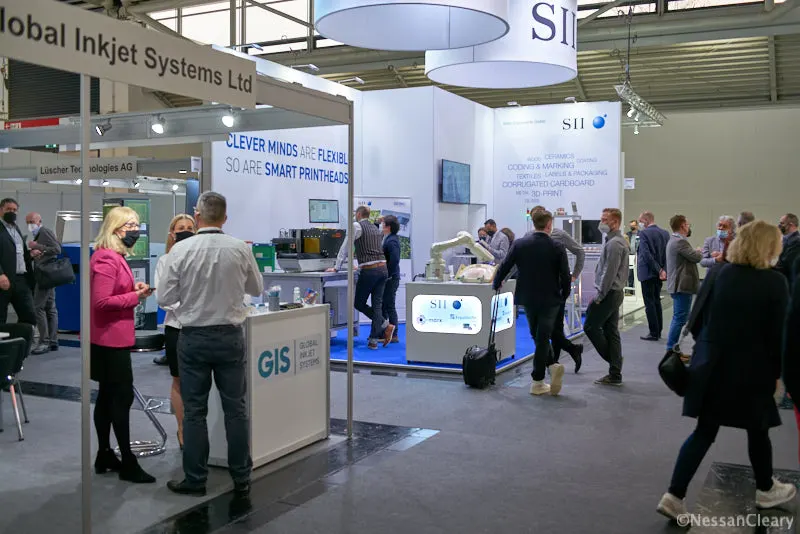There’s no denying it – trade shows are inevitably a little different in this Covid-driven age of hibernation and social distancing. But then InPrint has always been different from other trade shows anyway. This time around it’s a smaller show but if anything the spirit of the show is stronger than ever.
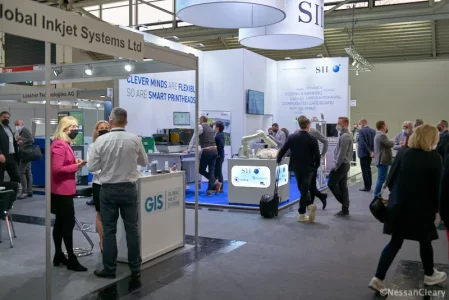
Overall InPrint felt quite busy with many people simply pleased to be able to meet in person.
It does seem strange to write about the ‘spirit’ of a trade show, when really these events are mostly about marketing and hopefully selling equipment. But InPrint has never been that kind of show. Instead it has been a place where potential customers learn about inkjet and whether or not it could work for them, and the vendors network with each other and look for partnerships and projects to collaborate on. There was a very real sense of relief at the show that at last people could meet face to face and wander from stand to stand. Debbie Thorp, business development director for GIS, summed this up neatly, saying: “Nothing beats face to face conversations. You can leap around from subject to subject so much quicker when you talk to somebody face to face.”
John Mills, CEO of Xaar, says that often printhead vendors talk with OEMs about developing a solution for a particular market but that he wouldn’t expect to meet OEMs at a show like InPrint. He explained: “The reason why we are here is that you get people who really want to put some digital print in their production line and don’t know where to start. And I think that InPrint is a good place to start.”
He adds: “The applications are quite diverse. We see lots of people interested in Printed Circuit Boards, glass printing, flooring, electronics. We see a lot of the big electronics manufacturers who are looking to replace certain processes in their manufacturing, all the way through to various decoration producers.”
He continues: “Our heads have got the widest viscosity range so if you are thinking about printing an ink with a lot of functionality, it might be a very viscous ink but we can jet it at 100mpm, and that’s well beyond anything that our competitors can do. So the more degrees of freedom we can give a customer, the more chance we have to develop a solution that works and that’s where we see our value proposition.”
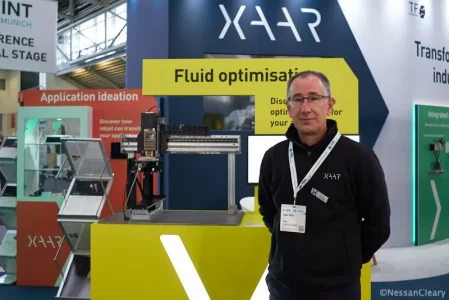
John Mills, CEO of Xaar, at InPrint.
Xaar used the show to introduce a new print engine, the Versatex. This is primarily aimed at industrial users that are looking to integrate some form of digital printing into their production, rather than OEMs hoping to develop and sell a complete printing system. Thus the Versatex includes an ink supply system and data path as well as a printhead, with users free to choose whichever head is the most appropriate for their needs from Xaar’s ImagineX range. The Versatex can be supplied both as an evaluation kit and a larger print engine, and can be configured with multiple printheads up to 420mm in width.
Mills points out that Xaar can also supply a range of electronics, ink supply systems and software, and has good relationships with ink suppliers, adding: “So, it’s really a one-stop shop with heads, ink, electronics, software and the print bar, we can give the whole lot.”
Xaar also showed off the GS3 version of its Nitrox Elite printhead. This offers smaller droplets than other versions, down to 3pl, which should produce higher definition images with smoother skin tones and gradients. As such, it’s suitable for both graphics uses, such as labelling, and for functional fluid applications, such as PCB printing.
Xerox used the show to highlight its M-series printheads, which are mainly aimed at scanning applications, and the W-series, that are suitable for single pass printers. The W-series, which were developed for the Baltoro inkjet press, are available as the W-1, with a single colour channel, or as the W-2, with two channels, but are otherwise identical.
Xerox will be launching an 80Khz version of these W-series heads later this year, which should be available either end of 2022 or early 2023. This will be able to run at close to 100mpm at 1200 dpi – up from 70mpm at 1200 dpi with the current 64Khz versions.
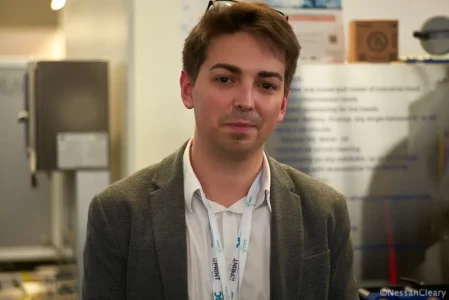
Marc Granero, inkjet sales manager for Kao Chimigraf.
Kao Chimgraf showed off an interesting silver ink. This is available in two versions, with one aimed at decorative effects such as label printing, and the other as a conductive ink for functional uses. Marc Granero, inkjet sales manager for Kao Chimigraf, explains: “We are able to encapsulate the pigment and make it very dispersible so that it doesn’t agglomerate and doesn’t clog the nozzles.”
This ink does give a very nice silver mirrored effect though it will require a primer or top coat to improve adhesion, depending on the substrate in use. Granero adds: “But I think the OEMs are used to this because the most difficult part is to find an ink that is inkjet friendly.”
He says that these inks will work with just about any piezo-electric printhead as well as HP thermal cartridges, and that it’s not necessary for these printheads to have any form of recirculation. The standard ink has roughly 11-12cP viscosity at ambient room temperature but the viscosity and the surface tension can be modified for each printhead.
The ink is developed and manufactured in Japan with Granero noting: “The most difficult part was to develop the encapsulation.” It’s available now and Kao Chimgraf is actively looking for partners to work with.
Agfa showed off a number of industrial print applications that have used its inks, as well as promoting its Interiojet industrial decor printer.
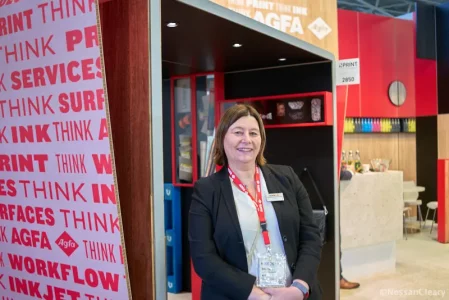
Rita Torfs, product manager for industrial inks at Agfa.
Rita Torfs, product manager for industrial inks at Agfa, says that Agfa has developed a water-based ink suitable for both folding carton and corrugated media, both coated and uncoated, and which is now in its final stages of development. The ink does not use any form of binder but does require a separate primer. The same ink can be used for both folding carton and corrugated but the primer is different as this depends on the porosity of the substrate.
Agfa is offering an analogue primer that can be applied via a flexo roller, which is a process that most converters are comfortable working with. However, Torfs says that Agfa is also developing a digital primer for those that want to go fully digital though this is currently only available for coated media. In theory, it should be cheaper to apply the coating via flexo but she points out that jetting it digitally requires a lot less primer as it only needs to be applied where it’s needed.
The Austrian company Inkatronic has developed ink management systems for both single pass and scanning inkjet printers. These are mostly aimed at prototyping and lab work. The company did demonstrate an interesting ink delivery system that several of the printhead vendors pointed out to me. This will work with most types of printheads as well as multiple heads on a print bar. It can be used together with a drop watcher and it’s said to be easy to switch between different ink types. It can automatically run filling, draining and cleaning cycles, including recirculating ink through the head to de-aerate it. Paul Lang, head of software engineering, says that it can generate a graph of the pressure in the tank, adding: “We can record this over, say, an hour, to measure the performance of the ink system during this time.”
Debbie Thorp says that GIS has had a lot of interest in its direct-to-shape solutions, noting: “The shapes that people are printing to now are much more complex than they used to be.” This is particularly true in the automotive sector where the increasing number of electric vehicles are having an impact on the way that cars are designed. Thorp explains: “A lot of the cars are going touch screen and it’s all smooth so they want some texture which you can do with inkjet using an automotive approved coating.”
She adds: “Texture is a common theme in automotive but we are also seeing it in the decoration and packaging markets. People want a more tactile effect.”
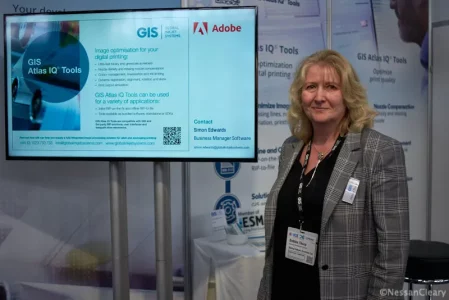
Debbie Thorp, Business Development Director at GIS
GIS demonstrated its Atlas workflow software, which has been updated to make it more modular, following on from a partnership agreement with Esko in 2020. The company has also developed a more integrated DFE that can be modified for different applications such as book printing.
GIS was recently acquired by Nano Dimension and the two companies are still figuring out the details as to how they will work together. Thorp says: “We have a very clear strategy of what we would like to do. They want us to carry on with our existing business but our potential roadmap has suddenly opened up and will accelerate in a way that it couldn’t have done before.”
Holly Steedman, business development manager for Integration Technology, says that “curing is often left as an afterthought but we want people to be thinking about it right from the beginning, not just the ink and the printheads but the whole system. Our target is to be better positioned with ink suppliers.”
She says that the customers are becoming more knowledgeable and that many machine builders are not coming from the inkjet world, adding: “This is great for us. We need more diverse machine builders. But they also need to be integrated into the industry and supported.”
Marketing manager Neil Strickland echoes this saying: “Ultimately the whole industry needs to communicate with one another.” Steedman concludes: “People have had more time during the pandemic to consider what they are doing. It’s given people a breathing space and now they are coming back.”

From left: Neil Stickland, Marketing Manager, and Holly Steedman, Business Development Manager, at Integration Technology.
Polytype showed off several samples of its rigid containers. The company develops inkjet printers for specific industrial applications, such as direct to shape bottles, plastic cartridges and metal canisters. Graphics can be printed directly to the containers, obviating the need for labels. This is mainly aimed at short production runs, for personalisation but also for short un customisations such as localised marketing campaigns, as well as individual tracking codes. Florian Fassler, head of digital technologies, points out that in some cases, such as plastic cartridges, inkjet is more cost effective than silk screening on longer runs because of the number of screens that would otherwise have to be made up. The company also develops its own software and electronics. Fassler says that Polytype sells both to industrial manufacturers looking to digitise their own production as well as to OEMs. He adds that Polytype is also looking at the automotive sector, noting: “They are also printing to curved plastic parts like we do so that creates a nice synergy.”
In conclusion, InPrint is sometimes a hard show to pin down because the term ‘industrial printing’ often means different things to different people. In previous years, the show has been paired with the giant manufacturing show Productronica, which pulls in people looking at different ways of manufacturing products. At that time, InPrint often seemed ahead of its time, with many of those manufacturers interested in the possibilities of inkjet but not yet ready to actually use it. In some of those earlier outings it seemed as if many conversations at InPrint instead revolved around using inkjet in packaging production. But this year, with InPrint paired with two packaging shows – ICE and CCE – I had the impression that many of the visitors were much more aware of the potential that inkjet technology offers and how they could use it within their manufacturing lines.
Overall, the show did feel quite busy and all the vendors seemed pleased with the level of business they were doing there. It was smaller than normal – I would estimate that InPrint was about 40 percent of the size that it would normally be in the years before the pandemic. However, this was not immediately obvious since InPrint shared a hall with CCE, which I will cover separately.
Editor’s note: If you are interested to see tradeshows back in bloom this Spring, please also see recent coverage of inkjet and ceramics at Expo Revestir

